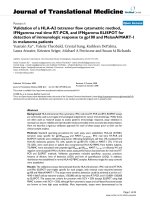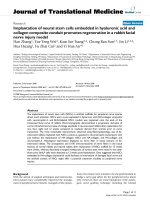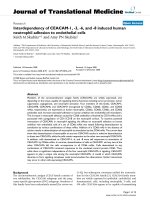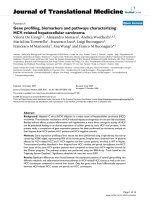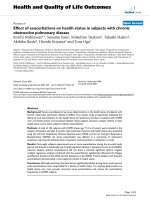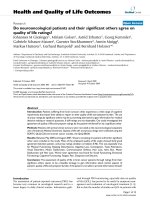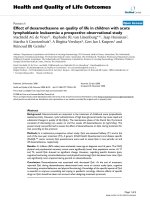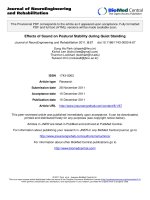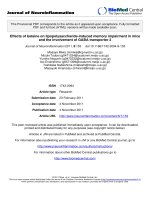Báo cáo hóa học: "Investigation of electrical and magnetic properties of ferro-nanofluid on transformers" pptx
Bạn đang xem bản rút gọn của tài liệu. Xem và tải ngay bản đầy đủ của tài liệu tại đây (836.09 KB, 5 trang )
NANO EXPRESS Open Access
Investigation of electrical and magnetic
properties of ferro-nanofluid on transformers
Tsung-Han Tsai
1
, Ping-Hei Chen
1*
, Da-Sheng Lee
2
and Chin-Ting Yang
3
Abstract
This study investigated a simple model of transformers that have liquid magnetic cores with different
concentrations of ferro-nanofluids. The simple model was built on a capillary by enamel-insulated wires and with
ferro-nanofluid loaded in the capillary. The ferro-nanofluid was fabricated by a chemical co-p recipitation method.
The performances of the transformers with either air core or ferro-nanofluid at different concentrations of
nanoparticles of 0.25, 0.5, 0.75, and 1 M were measured and simulated at frequencies ranging from 100 kHz to
100 MHz. The experimental results indicated that the inductance and coupling coefficient of coils grew with the
increment of the ferro-nanofluid concentration. The presence of ferro-nanofluid increased resistance, yielding to the
decrement of the quality factor, owing to the phase lag between the external magnetic field and the
magnetization of the material.
Introduction
In coming decades, new generations of electronic
products such as mobile phones, notebooks, and e-paper
will be developed with the primary goals of mobilization
and miniaturization. New CMOS fabrication technology
will be applied to fabricate the miniaturized IC of electro-
nic products o n silicon substrates, including on-chip
micro-transformers. Several issues of on-chip micro-
transformers have been investigated for man y y ears
[1-21]. Some researches focused on the material of the
magnetic core [1-10] and the geometry of the transfor-
mer [11-14]. Some papers discussed the parasitic effect of
the conductive substrates. Transformer losses become
dramatic at high frequencies and limit the performance
of the transformers. Previous studies have discusse d in
detail the causes of transformer losses such as parasitic
capacitance, ohmic loss, and substrate loss [15-18]. Core
loss from the solid magnetic core significantly affected
the performance of the transformers. The solutions for
the solid magnetic core loss were proposed [19-21].
Consequently, only a few studies addressed transfor-
mers with liquid magnetic cores. The liquid magnetic
core, ferro-nanofluid, with its distinguishing features of
low electric conductivity and super-paramagnetism is
regarded as a solution to the core losses of eddy current
and hysteresis. In this study, a ferro-nanofluid was
applied as a liquid magnetic core in a transformer. The
performance of the transformer with t he ferro-
nanofluids was measured, simulated, and compared with
that of a transformer with an air core.
Experiment
The ingredients of ferro-nanofluid used in this study were
Fe
3
O
4
nanoparticles, oleic acid, and diesel oil. The oil-
based Fe
3
O
4
nanofluid was synthesized by co-precipitation,
surface modification, nanoparticles dis persing, and base-
fluid phase changing [10].
TheshapeandsizeoftheFe
3
O
4
nanoparticles was
examined by a transmission electron microscope (TEM).
Figure 1 shows the TEM photo of the Fe
3
O
4
nanoparti-
cles. The average diameter of the nanoparticles was
approximately 10 nm. The crystalline phases of Fe
3
O
4
nanoparticles were determined by X-ray diffraction, as
shown in Figure 2. The magnetic properties of Fe
3
O
4
nanofluid were measured by a vibrating sample magnet-
ometer (VSM). The magnetized curve of the Fe
3
O
4
nanofluid measured by a VSM is shown in Figure 3.
The measured results illustrate that the synthesized
ferro-nanofluids have the characteristic of super-para-
magnetism. The saturated magnetizations of 0.25, 0.5,
0.75, and 1 M Fe
3
O
4
nanofluids were 3.75, 8.85, 12.7,
and 16.7 emu/g, respectively.
* Correspondence:
1
Department of Mechanical Engineering, National Taiwan Universi ty, No. 1,
Sec. 4, Roosevelt Rd., Taipei 10617, Taiwan
Full list of author information is available at the end of the article
Tsai et al. Nanoscale Research Letters 2011, 6:264
/>© 2011 Tsai et al; licensee Spri nger. This is an Open Access article distributed under the t erms of the Creative Commons Attribution
License ( which permi ts unrestricted use, distribution, and reproduction in any medium,
provided the original work is properly cited.
A liquid magnetic core of a transformer was used in
this study; the capillary served as a container in which
the Fe
3
O
4
nanofluid was loaded. The coils of the trans-
former were made by winding enamel-insulated wires
on a capillary. Figure 4 shows the transformer on a
capillary, which loads the oil-based Fe
3
O
4
nanofluid.
The diameter of the enamel-insulated wire used was
0.45 mm, and the thickness of the enamel layer was
approximately 0.05 mm. The primary and secondary
windings had 20 turns. The outer and inner diameters
of the capillary were 3.2 and 2.3 mm, respectively, and
the capacity of the capillary was 100 μL.
Results and discussion
Different magnetic cores, air, and Fe
3
O
4
nanofluids of
0.25, 0.5, 0.75, and 1 M were applied as the magnetic
core of transformers. The inductance (L), coupling coef-
ficient (K), resistance (R), and quality factor (Q)were
measured by an Agilent 4294A Precision Impedance
Analyzer. In this study, the simulation of the transfor-
mer was also established with HFSS 3D Full-wave Elec-
tromagnetic Field Simulation. By applying measured
permeability, permittivity, and magnetic tangent loss
and setting exciting sources, the impedances will be cal-
culated by the finite element method. Both the frequen-
cies of measurement and simulation range from 100
kHz to 100 MHz.
Figure 5 shows the inductances of the coils of the
transformers with different magnetic cores. Figure 5
illustrates that the induct ance grows linearly with the
increase of Fe
3
O
4
concentration. At frequencies ranging
from 100 kHz to 15 MHz, the inductances decrease
rapidly due to the skin effect of coils. At frequencies
ranging from 15 to 100 MHz, the inductances increase
gradually and approach the maximum inductance at the
Figure 1 The TEM photo of Fe
3
O
4
nanoparticles.
Figure 2 The crystalline phases of Fe
3
O
4
nanoparticles.
Figure 4 The transformer on a capill ary that loads the oil-
based Fe
3
O
4
nanofluid.
Figure 3 The magnetized curve of the Fe
3
O
4
nanofluid
measured by a VSM.
Tsai et al. Nanoscale Research Letters 2011, 6:264
/>Page 2 of 5
resonance frequency. Figure 6 shows the measured and
simulated results of the coupling coefficients of the
transformers with different magnetic cores. The
coupling coefficients also increase with the increase of
Fe
3
O
4
concentration. It increases rapidly below frequen-
cies of 5 MHz and increases gradually with frequencies
over 5 MHz. These results show that the magnetic cores
of nanofluids can improve the inductance and coupling
coefficients.
Figure 7 shows that the resistance increases with the
increase of Fe
3
O
4
concentr ation, and it increases as a
functi on of frequency. At 100 MHz, the resistance s with
themagneticcoreof0.25and1MFe
3
O
4
nanofluids
were two and five time s the resistance as the air cor e. It
is speculated that this is because of the phase lag on the
material magnetization behind the external magnetic
field at high frequencies. When the relaxation times
cannot keep up the alternate time of the magnetic field,
the resistance of the coils will grow rapidly [10,22]. At
high frequencies, the permeabi lity should be regarded as
a complex number. Rearranging complex permeability
and the inductance of a solenoid-type inductor, the
impedance equation is obtained as follows:
Z = R + jωL = R + ω
μ
N
2
A
l
+ jω
μ
N
2
A
l
(1)
where ω is the angular frequency, N is the turns of
coil, A is the cross-sectio nal area of solenoid, and l is
the length of solenoid, μ” is the real part of complex
permeability, and μ” is the imaginary part of complex
permeability. It can be observed that the imaginar y part
of complex permeability μ” reflects on the real part of
impedance, which is the cause of increasing resistance.
Then, the quality factor Q, which is defined as the ratio
of inductance to resistance, becomes [10]:
Q ≡
Im(Z)
Re
(
Z
)
=
ωμ
N
2
A
Rl + ωμ
N
2
A
(2)
Figure 8 shows the quality factor of coils of transformers
with different magnetic cores. Owing to the fact that the
increase of resistance is larger and faster than that of
inductance with the presence of Fe
3
O
4
nanofluids, the
quality factor decreases when the Fe
3
O
4
concentration
rises. The simulated results show the same trend.
Conclusions
In this study, different concentrations of ferro-nanofluids
were applied to the magnetic cores of transformers. The
performance of transformers with magnetic cores of air
Figure 6 The coupling coefficients of transformers with different magnetic cores: (a) measured data; (b) simulated data.
Figure 5 The inductances of coils of transformers with
different magnetic cores.
Tsai et al. Nanoscale Research Letters 2011, 6:264
/>Page 3 of 5
and Fe
3
O
4
nanofluids of 0.2 5, 0.5, 0.75, and 1 M were
measured, simulated, and compared. The experimental
results indicated that the presence of Fe
3
O
4
improved the
inductance and the coupling coefficient of the coils. Due
to phase lag on the material magnetizatio n behind the
external magnetic field at high frequencies, the resistance
increased larger and faster than inductance, thus yielding a
lower quality factor. For a micro- transformer, if a solid
magnetic core is needed for higher inductance, it could be
achieved by adding ferro-nanofluid and removing the base
fluid repeatedly. This method has a lower thermal budget
than the processes that sputtered or electroplated materi-
als on chips. It is compatible with the MEMS process.
Abbreviations
TEM: transmission electron microscope; VSM: vibrating sample
magnetometer.
Acknowledgements
The authors deeply appreciate the financial support provided by the
National Science Council in Taiwan under the grant numbers of NSC 96-
2628-E-002-194-MY3 and NSC 98-3114-E-002-002-CC2.
Author details
1
Department of Mechanical Engineering, National Taiwan Universi ty, No. 1,
Sec. 4, Roosevelt Rd., Taipei 10617, Taiwan
2
Department of Energy and
Refrigerating Air-conditioning Engineering, National Taipei University of
Technology, No. 1, Sec. 3, Chung-hsiao E. Rd., Taipei 10608, Taiwan
3
Department of Mechanical and Computer-Aided Engineering, St. John’s
University, No. 499, Sec. 4, Tam-king Rd., Tamsui, Taipei 25135, Taiwan
Authors’ contributions
TH performed experimental investigations of electric and magnetic
properties of ferro-nanofluids on transformers and prepared the draft, PH
proposed the phenomena for investigation and revised the manuscript, DS
suggested the theory for the explanation of measured results, and CT
designed the experimental systems. All authors read and approved the final
manuscript.
Competing interests
The authors declare that they have no competing interests.
Received: 5 November 2010 Accepted: 28 March 2011
Published: 28 March 2011
References
1. Ryu HJ, Han SH, Kim HJ: Characteristics of twin spiral type thin film
inductor with Fe-based nanocrystalline core. IEEE Trans Magn 1999,
35:3568-3570.
2. Kim CS, Bae S, Kim HJ, Nam SE, Kim HJ: Fabrication of high frequency DC-
DC converter using Ti/FeTaN film inductor. IEEE Trans Magn 2001,
37:2894-2896.
3. Kim KH, Kim J, Kim HJ, Han SH, Kim HJ: A megahertz switching DC/DC
converter using FeBN thin film inductor. IEEE Trans Magn 2002,
38:3162-3164.
Figure 8 The quality factors of coils of transformers with different magnetic cores: (a) measured data; (b) simulated data.
Figure 7 The resistances of coils of transformers with different
magnetic cores.
Tsai et al. Nanoscale Research Letters 2011, 6:264
/>Page 4 of 5
4. Zhuang Y, Rejaei B, Boellaard E, Vroubel M, Burghartz JN: Integrated
solenoid inductors with patterned, sputter-deposited Cr/Fe10C090/Cr
ferromagnetic cores. IEEE Electron Dev Lett 2003, 24:224-226.
5. Brandon EJ, Wesseling E, White V, Ramsey C, Castillo LD, Lieneweg U:
Fabrication and characterization of microinductors for distributed power
converters. IEEE Trans Magn 2003, 39:2049-2056.
6. Wang N, O’Donnell T, Roy S, Brunet M, McCloskey P, O’Mathuna SC: High-
frequency micro-machined power inductors. J Magn Magn Mater 2005,
290-291:1347-1350.
7. Gao XY, Cao Y, Zhou Y, Ding W, Lei C, Chen JA: Fabrication of solenoid-
type inductor with electroplated NiFe magnetic core. J Magn Magn Mater
2006, 305:207-211.
8. Lei C, Zhou Y, Gao XY, Ding W, Cao Y, Choi H, Won JH: Fabrication of a
solenoid-type inductor with Fe-based soft magnetic core. J Magn Magn
Mater 2007, 308:284-288.
9. Lee DS: Energy harvesting chip and the chip based power supply
development for a wireless sensor network. Sensors 2008, 8:7690-7714.
10. Tsai TH, Kuo LS, Chen PH, Lee DS, Yang CT: Applications of ferro-nanofluid
on a micro-transformer. Sensors 2010, 10:8161-8172.
11. Prieto MJ, Pernia AM, Lopera JM, Martin JA, Nuno F: Design and analysis of
thick-film integrated inductors for power converters. IEEE Trans Ind Appl
2002, 38:543-552.
12. Seemann K, Leiste H, Beckker V: A new generation of CMOS-compatible
high frequency micro-inductors with ferromagnetic cores: theory,
fabrication and characterization. J Magn Magn Mater 2006, 302:321-326.
13. Yamaguchi M, Kim KH, Ikedaa S: Soft magnetic materials application in
the RF range. J Magn Magn Mater 2006, 304:208-213.
14. Dai CL, Chen YL: Modeling and manufacturing of micromechanical RF
switch with inductors. Sensors 2007, 7:2660-2670.
15. Yoon JB, Kim BI, Choi YS, Yoon E: 3-D construction of monolithic passive
components for RF and microwave ICs using thick-metal surface
micromachining technology. IEEE Trans Microw Theory Techn 2003,
51:279-288.
16. Chong K, Xie YH: High-performance on-chip transformers. IEEE Electron
Dev Lett 2005, 26:557-559.
17. Yunas J, Hamzah AA, Majlis BY: Fabrication and characterization of surface
micromachined stacked transformer on glass substrate.
Microelectron Eng
2009, 86:2020-2025.
18. Yunas J, Hamzah AA, Majlis BY: Surface micromachined on-chip
transformer fabricated on glass substrate. Microsyst Technol 2009,
15:547-552.
19. Xu M, Liakopoulos TM, Ahn CH: A microfabricated transformer for high-
frequency power or signal conversion. IEEE Trans Magn 1998,
34:1369-1371.
20. Park JW, Allen MG: Ultralow-profile micromachined power inductors with
highly laminated Ni/Fe cores: application to low-megahertz DC-DC
converters. IEEE Trans Magn 2003, 39:3184-3186.
21. Zhao JH, Zhu J, Chen ZM, Liu ZW: Radio-frequency planar integrated
inductor with permalloy-Si02 granular films. IEEE Trans Magn 2005,
41:2334-2338.
22. Kotitz R, Weitschies W, Trahms L, Semmler W: Investigation of Brownian
and Neel relaxation in magnetic fluids. J Magn Magn Mater 1999,
201:102-104.
doi:10.1186/1556-276X-6-264
Cite this article as: Tsai et al.: Investigation of electrical and magnetic
properties of ferro-nanofluid on transformers. Nanoscale Research Letters
2011 6:264.
Submit your manuscript to a
journal and benefi t from:
7 Convenient online submission
7 Rigorous peer review
7 Immediate publication on acceptance
7 Open access: articles freely available online
7 High visibility within the fi eld
7 Retaining the copyright to your article
Submit your next manuscript at 7 springeropen.com
Tsai et al. Nanoscale Research Letters 2011, 6:264
/>Page 5 of 5
